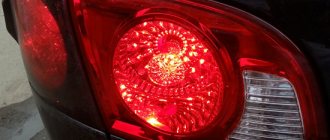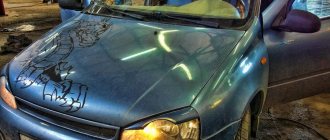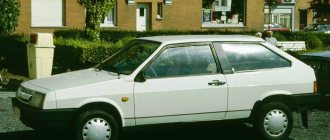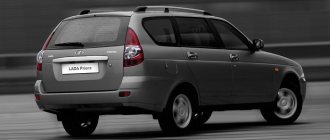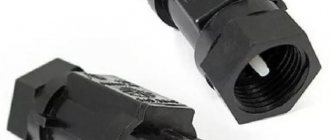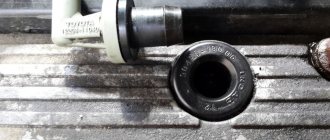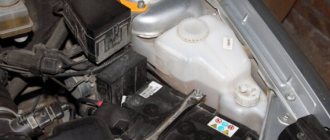Who knocked? Steering end
Of course, the goal of diagnostics is to find the faulty part and replace it. To check the condition of the tie rod end, you need to lift the car (the wheel should not touch the ground). Then it must be rocked in a special way, applying force at the “9 o’clock” or “3 o’clock” point. This swaying will allow you to feel the backlash. If it exists, you need to understand its source.
First, let's find out whether the steering tip is to blame for this. To do this, we swing the wheel in the same plane with one hand, and place the other hand behind the wheel and place it so that it touches the steering tip and the steering knuckle. If there is a gap there, you can easily feel it when rocking.
Replacement
Well, now let's proceed directly to the replacement procedure. The work cannot be called difficult, but without a certain set of tools you will not be able to achieve the desired result.
When there is no special puller
Therefore, you should have:
- Reliable jack;
- Balloon wrench;
- Pliers;
- Socket wrenches or open-end wrenches (the first option is better);
- Puller for tie rod ends;
- The Almighty WD40 Rust Remover;
- Hammer;
- Brush for working on metal.
Replacement process
Is everything ready? Begin.
- Place the car on an overpass or inspection hole, install anti-roll bars under the wheels, engage the handbrake and gear. Safety comes first.
- Using a wheel wrench or a suitable socket with a long wrench, unscrew the wheel bolts, but do not completely unscrew them.
- Properly position the jack and lift the vehicle, lifting the wheels off the ground. To increase reliability and stability, it is better to place something like bricks, a stump or other similar support under the car. Having one jack is not enough; it is very dangerous.
- Now you can completely unscrew the bolts and remove the wheels.
- Turn the steering wheel to the side all the way, which will provide you with fairly comfortable access to the place of work.
- Using a metal brush, clean the threads of the tip, and then be sure to treat the area with a rust killer - WD40. Both threads should be processed - the thread where the tip is screwed into the rod and the thread on the finger.
- Wait a while for the product to react. After this, take pliers or pliers, with which you need to unpin the tie rod end connection.
- Using a spanner wrench, unscrew the fastening nuts of the damaged, failed tip. If problems arise when unscrewing, the fasteners do not want to come off, treat with a wedge again, wait and try again. Take a larger lever, which will make the task easier.
- After removing the nut, you need to remove the tip pin from the stand. This is where a tie rod end puller will come in handy. You can buy it or borrow it from friends. But many people don’t have such a puller. Therefore, craftsmen found a way out of this situation.
- To remove it you will need a hammer, physical strength and a pry bar.
- Screw the nut onto the tie rod end pin so that the pin does not stick out.
- Use the pry bar to rest against the protrusion of the stand and begin to pry the rod upwards.
- With precise straight blows using a hammer, begin to knock the tip up. The blows are applied at the junction.
- With this artisanal method of dismantling, the most important thing is your accuracy when striking. Hit as accurately as possible so as not to damage other suspension components of your VAZ 2109.
- When the finger is finally removed, you can proceed to further steps.
- Unscrew the lever from the steering rod. But before that, be sure to measure the screw-in distance of the tip. This way you can more accurately install the new element at the toe angles.
- Measuring the distance is often done by eye, relying on marks from the old tip. Apply a mark or simply use a ruler or tape measure.
- Unscrew your damaged end from the rod. Here you can already do everything manually.
Not difficult, but long
In the process of replacing tie rod ends, many people relax after dismantling the old elements. In fact, reassembly is an equally important stage of repair, on which the overall result largely depends.
What does this have to do with the ball joint?
There is a possibility that the gap will not be detected, although the play will be obvious. And here you should suspect problems with the ball joint. You can check whether it is really faulty in the same way as in the case of diagnosing the steering tip. It is necessary to rock the wheel by placing one hand on the ball joint. If there is a gap, it will be impossible not to notice it.
If you discover malfunctions during the diagnostics described, do not delay in replacing damaged parts. This can lead to their permanent breakdown during the trip and a serious accident. After the repair, do not forget to go to a service center to have the wheel toe angles adjusted. It is necessary!
- How to remove a wheel if the edges of a bolt or nut are torn off, see (and read) here.
Please send all questions and suggestions regarding the “Technical Environment” series of issues to:
Other episodes of “Technical Environment” are available in our special project, as well as on our YouTube channel.
avtoexperts.ru
There are several types of steering mechanisms, but there is always a common part - this is the steering tip. The main task is to transfer a certain movement from the steering rod to the steering knuckle. Depending on the configurations, there can be from 4 to 6 parts.
For example, if the type of steering system is rack and pinion (the majority of them), then there will be four tips, 2 per rod (2 rods). If the mechanism is of the so-called “worm” type, there will be six, two per rod (rod 3).
Device
Please note that depending on the steering system configuration, they may vary in shape and size. The rod can be of different lengths or have bends, both in horizontal and vertical positions. Therefore, it is important to remember that if there is a bend, then the part is not interchangeable with the same one, but on the other side.
If they are initially the same in shape, there are no bends, then they can be replaced from one side to the other without consequences.
Remember, the main components:
• Directly the housing into which the steering rod is screwed.
• “Finger”, as a rule, on most models there is a thread or another type of connection, for example, a stud.
• Hinge housing uses wear-resistant metal for long service life.
• Various locking rings that prevent the pin, spring (to securely hold the liners) and liners from popping out.
• The “finger” nut is a fairly important part; without it it is impossible to secure the tip to the “fist”.
• Anther. Rubber pad that protects the device from dirt, dust, sand, and moisture.
Looking ahead, I would like to clarify the importance of maintaining this anther in an intact state. Otherwise, failure is inevitable. As a rule, in most cases, breakdowns occur due to a collapsed boot and the entry of foreign objects into it.
Almost all devices have the same shape, regardless of the car model. The only exceptions may be based on the format of the material used for production. For example, SUVs require more wear-resistant parts with increased protection due to the special conditions of possible operation.
Types of steering tips
Depending on what type:
It depends on whether there is a special hole on the support cover for pouring lubricant. As you understand, those being serviced have such a hole, which allows you to periodically add lubricant. The second option does not have this option, so after the lubrication is complete, they are thrown away because their maintainability is zero.
There is a second subdivision group:
Collapsible ones have a thread on the bottom cover (under the “finger”), which allows you to replace the hinge mechanism itself or the liner separately (a rubber or Teflon part that tightly fixes the “finger” in the “cup”). In modern cars, this principle is already difficult to find, because in terms of safety they are seriously inferior to non-separable parts. If the tip has failed in the car, you should inspect whether there is a thread on the cap or a retaining ring. If you do not find something like this, you can safely throw such a part into the scrap yard.
Malfunctions
Often, there are no problems with them, especially if they are new, which cannot be said about worn-out parts. During operation, the liners are necessarily worn down or deformed, causing a noticeable backlash to appear. Apparently the “finger” is already quite loose in the body. If the situation worsens, he can simply pull out the “stopper” and jump out.
Keep in mind that the tip can lead to quite serious consequences; the rod may break, which will lead to more dire consequences, including an accident. You basically lose control of the car, without even being able to turn the wheels.
As a rule, the resource with proper operation is quite long, but one should not forget about the characteristics of the road surface, which directly affects the durability. The service life, on average, does not exceed 100,000 km; it is not uncommon, as on new cars, for parts to break.
Signs of malfunctions and how to check?
• Significant deterioration in controllability.
• The appearance of dull knocks, especially when turning.
• Feedback in the steering wheel, even with the smallest irregularities.
If you notice something from the list, do not aggravate it, check if everything is in order with the node. Doing this at home is quite simple. It is better to carry out the operation with an assistant. So, you need to have a hole, an overpass, or simply place the “front” on some hill so that you can crawl under it. We put the handbrake on, be sure to turn off the car. The person in the cabin turns the steering wheel, the second one at this time, carefully monitoring the movement of the tip. The play will be noticeable even visually, not to mention tactile touches.
In addition, when checking, pay attention not only to the presence of play, but also to the integrity of the anthers, connections to the “fist”, and also pay attention to the bushing (axis) itself, into which the rod is screwed. It is not uncommon for a “break” to occur in that place or a crack to appear.
How to replace?
You don't need any special knowledge in this matter. The main thing is to get a tool, it is easier with it, we are talking about a puller, such an element, which looks like a “shovel”, allows you to remove the part without serious damage. So, your actions:
1. Raise the car.
2. Remove the wheel, otherwise access will be blocked.
3. Unscrew the nut on the “finger”. It is important not to remove it completely; it will make it easier to “use” the puller.
4. Using a puller, squeeze out the tip. If you don’t have such a device, you can get by with a hammer, but be careful.
5. After removing it from the “fist” mount, unscrew the lock nut on the rod.
Don't forget to put a mark on the rod indicating where the nut was secured. To avoid subsequent camber adjustment.
6. Remove and install the new part according to the marks. It is advisable, when you unscrew the old part, to count how many turns it was tightened.
In conclusion, I would like to say that it is very important to periodically check the serviceability of this part in order to protect the car from much more serious problems and accidents . Checking is actually a “minute” matter, taking into account that there is nothing complicated in the mechanism, repairs can be done independently.
Knock in the steering rack: how to determine how to eliminate the knock
The design of a car includes dozens of different components. Some of them become unusable during operation, as evidenced by the appearance of specific sounds. One of these is a knock in the steering rack. In this article you will find useful information on how to determine the malfunction, what methods are available for diagnosing and repairing the breakdown.
WHY IS IT KNOCKING?
Of course, the main reason for steering rack failure is bad roads. But in order to carry out repair actions, you need to know what exactly is broken in the structure. In reality, there can be quite a few reasons for knocking, here are the main ones:
- Weak tightening of fastening connections.
- Failure of the plastic support sleeve.
- Damage to anthers.
The steering rack begins to knock due to the fact that its design uses soft material that is not designed for use on bad roads. It just crumples. Moreover, corrosion and wear can cause the gap between the teeth to increase.
When the support sleeve wears out, play is formed during movement, and as a result, the steering rack begins to knock. It's all about corrosion, which undermines the bushing. Protective covers are simply erased during use. Damages appear in them, through which dust and dirt get inside, wearing out the entire mechanism.
A few words about the steering rack
Modern rack and pinion mechanisms use two main components: the rack and the pinion. Thanks to such a simple design, the part has a long service life and is capable of properly performing its functions for more than 100 thousand kilometers. However, failure is possible, and then you will have to carry out repairs.
The operating principle of this device is also quite simple. When you turn the steering wheel, the rack begins to move in a given direction, which sets the rods in motion and also ensures that the wheels turn. It is recommended to carry out diagnostics immediately upon detecting a knock, since this component is responsible for driving the vehicle.
What are tie rods and is it worth postponing their repair?
I am glad to welcome you, friends, to the blog “Note to You”
There are many modern car enthusiasts who very often ignore problems that arise with the steering. And it seems that while the car is running, everything is fine, but as soon as problems arise, they simply send their “iron horse” to a service center. However, control problems should not be shelved, since they can lead to serious accidents.
To put it in simple language, the steering rod is a certain part of the drive that synchronizes the steering knuckle and the steering mechanism. Thus, controlling a car using the steering wheel is impossible without a steering system, where the main link is the steering rod.
The main task of the steering linkage is to ensure that the wheels turn at different angles, because they are part of the steering linkage. And thanks to the hinges mounted at the ends of the rods, it is possible to redistribute forces from the steering mechanism, which, in turn, helps to remain unchanged at the selected angle of rotation of the wheels of the car.
The main symptoms that indicate a failed steering linkage are:
— This may be a characteristic knock that occurs as a result of wear of the steering rod joints, as a result of wear of screw bearings and other numerous reasons. This is the most obvious sign that there is a breakdown in the steering rod of the car.
— Power steering fluid may also leak, which can be easily determined if you see the characteristic oil stains remaining where the car stops.
— Another symptom of a broken tie rod is the so-called “weighting” of the steering wheel, that is, when the steering wheel begins to turn very tightly and difficultly to the sides. It is especially worth considering repairs if this symptom is frequent.
— Also, when the steering wheel begins to return very poorly to its original position, this is another sign of a possible breakdown of the steering rod.
— Very poor synchronization when turning the steering wheel in the right direction and turning the wheels.
If at least one of the above-described symptoms suddenly appears, you should immediately think about dealing with the problem that has arisen as quickly as possible. Moreover, as a rule, all these signs indicate a traction malfunction, although there are often cases that the reason may be completely different. Therefore, in order to “get to the bottom” of the true problem, you have to completely disassemble the steering rod.
Diagnosing a malfunction is not as difficult as it might seem at first glance. It is enough to carry out a technical analysis of the traction and observe a little the behavior of the steering.
In addition, if the traction is faulty, you must be prepared for the fact that very soon the car may become completely uncontrollable. And this can lead to quite unpleasant consequences. So there is no need to delay identifying the problem and fixing the problem.
Well, in order to keep the steering rod and its elements in good condition for as long as possible, you need to constantly follow some simple recommendations:
- So, for example, in winter you shouldn’t move immediately. First you need to warm up the oil in the power steering.
— You also need to warm up the engine properly, and then turn the steering wheel in different directions.
— It’s also worth carefully monitoring the condition of the boot, because even minor damage can lead to failure of the steering rod.
— In addition, you should never forget about maintaining the integrity of all seals on the rod.
Thus, if you act correctly and constantly monitor the condition of the car’s steering linkage, the likelihood of breakdown will be minimized.
How to replace tie rods ⇓
Source: https://content-bis.com.ru/chto-takoe-rulevye-tyagi-i-stoit-li-otkladyvat-ix-remont.html
Causes of knocking
Despite its reliability, the rack design has several disadvantages. These include sensitivity to shock loads, difficulty in installation and a tendency to constant vibration. Under the influence of external loads, any component, of course, becomes unusable, which is why a characteristic knock appears.
The main reasons for this phenomenon include:
- The plastic bushing installed on the right or left side of the rack is severely worn. There is a strong backlash in the design, due to which drivers hear extraneous noise. This is especially noticeable when driving on a bad road.
- Poor tightening of connections in the steering mechanism design. It can be fixed quite simply (you need to tighten all the fasteners well).
- The appearance of corrosion, which destroys the metal and contributes to the formation of backlash.
- Damage to anthers. Dust, sand and dirt get into the structure, increasing wear of the part.
- Deformation of the crankcase, resulting in an incorrect angle between the screw and the teeth.
- Development of the resource of the central tooth.
A common problem is leakage in cars with power steering (power steering). The power steering design uses a special pump, which creates additional force when turning the steering wheel, making the process easier for the driver. When the seals fail, the pressure in the system drops, the working fluid leaks out, and accordingly, the steering wheel rotates with difficulty. As a result, this will lead to accelerated wear and knocking.
Prolonged downtime can cause the shaft to rust and difficulty turning the steering wheel, accompanied by knocking. If a hum also appears along with the knocking, this indicates a breakdown of the power steering pump. It does not build up the required pressure. The way out of the situation is to replace this component.
Most slats are made of soft metal that will wrinkle over time, so this part should be inspected regularly. Now you know why the steering rack is knocking, which means you can fix the problem.
Steering rod: device, malfunctions and replacement
It is necessary to clarify the point, some car enthusiasts do not distinguish the difference between a steering rod and a rack. And the differences are quite significant. You must understand that the rack is a full-fledged control mechanism, inside which a gear shaft (rack) moves, connecting to the rods, left and right. You can come across the concept of medium thrust, keep in mind that it is present in “worm” type systems, for example, the VAZ (Classic) or BMW models.
GAZ Cyber steering rods
By the way, the “Germans” used different types of steering systems on their models; you can find both a “worm” and a rack, for example, E39, E34, E38, etc.
Now the concept itself, steering rod, what is it? This is a part of the steering system of any car, which converts the physical impact of a person on the steering wheel into turning the wheel. Simply put, these are the connecting links between the steering column, steering wheel and wheels (in particular the steering “fists”). Without them, you simply would not be able to turn the wheel.
Device
Varieties
There are three varieties as such:
• Left
• Average
• Right
Middle tie rod
You can often find the decoding as longitudinal and transverse thrust. The second is the so-called middle thrust or central, as it is also called. The first is the left or right side.
Remember that such a number of elements is inherent only in the “worm” type of mechanism. Some note that this feature negatively affects handling, because the impacts from uneven roads are transmitted directly to the steering wheel, from which the driver feels everything personally.
There are more hinged (moving) elements, which means you have to monitor the condition of the parts much more often.
In racks, there is no such variety; the task of central thrust is performed by a toothed rack moving along the cylinder. Depending on the type of rack, it can be either “dry” or power steering or power steering.
The second type includes special seals that prevent fluid leakage. The steering rods (left and right) are connected to the rack.
Depending on the modification of the car, the connections can be either hinged or classic threaded. The connection between the rods and the steering knuckles occurs through hinges.
Device
Do not forget that they are separated and can be adjusted. Some come molded together with tips, without the possibility of adjustment. In other modifications, special bushings are provided at the edges into which the tips are screwed, with the possibility of adjusting the latter. Therefore, pay attention to what type you have; after replacement, you will need to adjust the camber.
Resource, faults and their symptoms
Nobody gives exact terms of operation. It is generally accepted that in general, in the entire control device, no matter what type it is, traction has the longest service life. They call the time frame 100,000 – 150,000 km. and even 250,000 km. But here it is necessary to make an important emphasis; in many respects everything depends on the driving style and the characteristics of the road surface. For example, on bumpy roads, it is clear that parts wear out faster.
While operating a car, every driver needs to pay attention to the appearance of strange sounds and deterioration in controllability; these may be the first “bells” that some element is failing.
Broken tie rod
So, the signs:
• A knocking or grinding noise appears while driving on uneven roads.
• Slight knocking when turning the steering wheel.
• Eaten rubber on one side.
• Backlash and general looseness of the element.
• Steering wheel wobble.
• The car “drives” if the steering wheel is straight.
• The “wheel” rotates slowly.
• A torn boot, as a rule, after exposure to dirt, dust, moisture, the hinge does not “live” for a long time.
The boot is torn
Often, malfunctions are associated with worn fasteners, both on the tips and on the side of the steering mechanism (for example, broken threads). After a strong blow to the suspension, it flew into a hole, it is not uncommon for the plane to change or bend. In such cases, it is better to replace the part, because restoring its original appearance without special tools will be labor-intensive. And as you understand, a “crooked” element cannot be distinguished by anything good in management.
Separately, I would like to say that the traction device includes a tip; most of the symptoms may be associated with its malfunctions. For example, the “finger” or polyurethane gasket that secures the hinge in the “socket” has worn out, which generally leads to the appearance of play.
Replacement
If diagnostics show wear, for example, of the tip, you can get by with replacing it. But, if the hinges are out of order on both sides, the threads are broken or the rod is basically maintenance-free, then, of course, a complete replacement will be needed. Therefore, we will provide a small work plan, what needs to be taken into account and what features of the repair. So:
• Loosen the wheels. We lift the car with a jack.
Don’t forget about safety precautions, place a brick or “shoe” under the wheel. Don't forget, you need to do this on the opposite side of the rise. That is, they raised the left side and placed a brick under the rear right wheel.
• So, the wheel has been unscrewed, now the rods are open to you. Remove the cotter pin and unscrew the pin nut.
Unscrew the steering wheel nut
By the way, it is advisable to measure the length of the old element; this will help you independently adjust the “fit” of the new part.
Let's take it off
• If you are removing only the tip, just unscrew it from the sleeve. But, if we are talking about a complete replacement, then you will have to remove the anthers (carefully), and only then unscrew the entire element. As a rule, key grooves are made on the rod for 32.
Next you need to remove the boot. New installed steering rod. Replacement photo - drive2.ru user Valery Zavgorodniy
Assembly is carried out in reverse order.
Source: https://avtoexperts.ru/article/chto-takoe-rulevaya-tyaga-neispravnosti-i-zamena/
Checking the steering rack
Knocking in a car can occur for several reasons. Many motorists ask how to determine a knock in the steering rack. You can do this in the following ways:
- Visually and audibly. You may hear superficial and internal knocking. The first occurs due to a ruptured boot. In this case, the tip is not protected in any way, so it quickly fails. An internal knock indicates a more serious breakdown, which is best diagnosed at a car service center.
- Check if there are any gaps in the steering rod joints.
- Disconnect the cross rods. If the knocking noise remains, then the problem is in the steering rack.
It is recommended to put the car on a lift or pit, and then ask someone to turn the steering wheel. Being directly under the car, you are more likely to be able to determine the source of the sound.
When purchasing a used car, diagnostics can become more complicated. The damage will be difficult to determine, since the previous owner may have completely replaced the boots with new ones, leaving the underlying problem without a solution. In such situations, it is better to completely dismantle the entire structure.
Sounds from the cabin
In modern cars, the steering wheel is not only needed to turn the car. It often houses controls for certain devices, from changing gears to turning on headlights or adjusting the audio system. Therefore, the driver has a natural concern when clicks appear in the steering column when turning the steering wheel. It is typical that the sound comes from inside the cabin from the area of the horn button.
In this case, there is no need to panic. First, you should check the correct installation and condition of the plastic lining of the column. The possibility of plastic deformation cannot be ruled out. A common reason for this phenomenon is a malfunction of individual elements of the steering column switch that produce such sounds. You can check the quality and fastening of the plastic, and replace the faulty switch. Often this is enough so that when you turn the steering wheel you won’t hear a click in the steering column.
Sometimes in the front part of the cabin, when you turn the steering wheel, squeaks are heard, similar to shuffling. Their source is hidden under the beep button on top of the speaker. At the same time, the signal for a problem with the airbag in the steering wheel comes on, and the cruise control buttons do not work.
We recommend: DIY methods for removing bumper scratches
This means that the steering column cable under the airbag is inoperative. It supplies power to the mechanism of this airbag, the horn and some other devices of the car. It could simply be seriously damaged. Some motorists try to fix such faults on their own. This does not provide any guarantee of reliable operation of the cable. Taking into account the fact that this device affects safety, it is better to replace the steering column cable by experienced car service workers.
Repair or complete replacement
If funds allow, then it is worth purchasing new parts, as they guarantee maximum service life. However, the cost of the gearbox is quite high. There is always a temptation to buy non-original parts. Sometimes they will not be inferior in quality to products from the official manufacturer, but there is always a chance to stumble upon a low-quality product.
An alternative option is to make high-quality repairs. To do this, a special repair kit is purchased, and then the oil seals, anthers and other components are replaced. If you have some experience in car repairs, then you can do it yourself. Otherwise, it is naturally recommended to contact a specialized auto repair shop. Repairing a power steering system is difficult, so it must be done by highly qualified craftsmen.
Repair procedure
Having purchased the necessary repair kit, you can begin dismantling. Here it is necessary to follow a certain algorithm consisting of the following steps:
- Completely dismantle the steering rack.
- Remove the tie rods.
- Clean the structure from dirt accumulated during operation.
- Replace worn parts.
- Inspect the shaft and install a new one if necessary.
Why remove the tie rods? This will greatly simplify the process of installing new boots. By pulling them onto the corresponding protrusions on the rod, you can achieve maximum tightness. Before assembling the rack, be sure to lubricate the internal oil seal.
If your car has a hydraulic booster, then you will first need to disconnect the high pressure pipes and then drain the working fluid into a prepared container. It is not recommended to remove the gearbox with hydraulic power steering yourself. The procedure involves dismantling the subframe, and it is impossible to do it alone.
The described technique will eliminate knocking in the steering rack. To complete the procedure, you will need a set of keys and screwdrivers, a garage with a pit. You can also always contact a car service center, where all the above operations will be performed by auto mechanics. But be careful, as they may jack up the cost of repairs or supply low-quality consumables.
If the steering rack is knocking, is it okay to drive?
Of course, your car will drive a certain number of kilometers with a knock, but it’s not worth taking risks and continuing to drive with it. In the worst case, the steering mechanism may simply jam. If this happens at high speed, the consequences will be dire.
Protect yourself and other road users. If knocking or humming occurs in the structure, be sure to carry out diagnostics or contact a service station. On some cars, due to the nature of the suspension, a slight knock in the rack may be quite normal. You can get detailed information about the problem for your make and model of car on thematic forums on the Internet.
Steering cardan
If, when turning the steering wheel, you hear a knocking sound from the steering column, then the steering wheel shaft driveshaft is most likely to blame. Very often UAZ owners face this problem. A malfunction occurs due to an increase in the gap in the spline joint. On VAZs, a knocking sound from the steering column occurs due to a broken universal joint. It can be heard both while driving and when turning the steering wheel back and forth in place.
You can check it with your hand - you need to hold the universal joint with one hand, and turn the steering wheel with the other; if it is loose, then repair is needed.
Many owners of domestic front-wheel drive VAZs - “Kalinas”, “Priors”, “Grants” - are faced with the fact that over time the crosspiece in the driveshaft begins to creak. Its diagnosis is carried out according to the procedure described above. If play and creaking are detected, the car owner can choose one of two options. The first is to buy a new cardan, the second is to try to repair the installed one.
Moreover, they are repaired not because of the high price, but because of a large number of defective new cardan shafts. In particular, we are talking about the fact that the cardan can “bite”. This is caused by the fact that its half with splines moves with jamming, and jerks are already felt in the new part. Accordingly, when purchasing a new crosspiece, you need to make sure that it moves freely in all directions. It often happens that in a fork with splines, the bearings are initially skewed due to misalignment of the holes. Therefore, it is up to the car owner to decide whether to buy a new cardan or not.
Another way out of the situation is to replace the existing needle bearings in the cardan crosspiece with caprolactane bushings. This option is supported by the fact that many taxi drivers who own VAZs, due to the fact that they have to turn the steering wheel a lot, do exactly this.
This option implies the complexity of repair work. As for dismantling, they usually use 13mm wrenches and a flat-head screwdriver.
Please note that in order to knock out the bearings it is necessary to strike the base of the fork under the bearing. You need to hit it carefully with a small hammer.
On the Internet you can find many conflicting reviews about various cardan shafts and bushings. For VAZ “Kalina”, “Priora”, “Granta” cars, crosspieces of the “CC20” and “TAYA” brands are often installed, or a more expensive option is Japanese spare parts Toyo and GMB.
